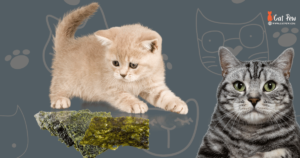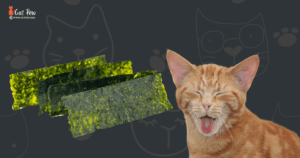Can Cats Safely Munch on Seaweed With Salt?
No, cats should not eat seaweed with salt, as it can harm their health. Seaweed is safe for cats and can provide some nutritional benefits, but adding salt can lead to electrolyte imbalances and digestive issues in felines.
The Potential Risks Of Cats Consuming Seaweed With Salt

In recent years, seaweed has gained popularity as a health food for humans due to its rich nutritional profile. Many pet owners wonder if this nutrient-packed marine plant can also benefit their feline friends. However, it is essential to understand that not all types of seaweed are safe for cats, especially if they contain added salt. This article will explore the potential risks associated with cats consuming seaweed with salt and the health concerns it can pose to our beloved pets.
Introduction To The Potential Dangers Of Cats Consuming Seaweed With Added Salt
While seaweed can offer certain health benefits to cats, such as being a source of vitamins, minerals, and fiber, adding salt changes the equation entirely. Salt, or sodium chloride, is a mineral that is essential for various bodily functions. However, like humans, excessive salt intake poses serious health risks for our feline companions.
Explanation Of Why Salt Can Be Harmful To Cats
When cats consume excessive amounts of salt, it can disrupt their delicate electrolyte balance, leading to dehydration and a range of health complications. Cats naturally have a low thirst drive, making them more dehydration-resistant. High levels of salt can exacerbate this issue and potentially cause urinary tract problems, such as an increased risk of bladder stones or even kidney damage.
Highlighting The Specific Risks And Health Concerns Associated With Salt Intake In Cats
When cats consume seaweed with added salt, they are exposed to higher sodium levels than their bodies can handle. This can lead to a condition known as hypernatremia, which is characterized by an excessive concentration of sodium in the bloodstream. Some of the specific risks and health concerns associated with salt intake in cats are:
- Increased thirst and frequent urination
- Dehydration
- Electrolyte imbalances
- High blood pressure
- Decreased kidney function
- Risk of bladder stones and urinary tract infections
- Potential damage to vital organs
Not all types of seaweed contain added salt; some varieties may even offer moderate health benefits when consumed in small quantities. However, it is crucial to consult with your veterinarian before introducing seaweed into your cat’s diet. They can guide you on safe options and recommend appropriate amounts to ensure your cat’s well-being is not compromised. Remember, it’s always better to be safe than sorry when it comes to your cat’s health.
Understanding The Nutritional Value Of Seaweed For Cats

Seaweed can be a nutritional addition to a cat’s diet, but it is essential to avoid seaweed with salt as it can harm their health.
Understanding the Nutritional Value of Seaweed for Cats Exploring the Nutritional Benefits of Seaweed for Felines When providing a well-rounded diet for our feline friends, it’s essential to consider all the potential options. One such option that has gained popularity in recent years is seaweed. Seaweed is not only a tasty treat for us humans but can also offer numerous nutritional benefits for our furry companions. In this section, we will delve into the nutritional value of seaweed for cats, exploring its vitamins and minerals and highlighting the potential advantages of incorporating this marine plant into their diet. Discussion on the Vitamins and Minerals Found in Seaweed Seaweed contains vitamins and minerals essential for a cat’s overall health and well-being. It is packed with an impressive array of nutrients, including but not limited to:
- Iodine: Seaweed is an excellent natural source of iodine. This mineral plays a vital role in regulating a cat’s thyroid function. Adequate levels of iodine help support a healthy metabolism and proper growth and development.
- Omega-3 Fatty Acids: Seaweed is often touted for its high omega-3 fatty acid content. These essential fatty acids are known for their anti-inflammatory properties and can benefit a cat’s skin, coat, and overall immune system.
- Vitamins A, B12, and C: Seaweed is a rich source of various vitamins. Vitamin A is necessary for good vision and a healthy immune system, while vitamin B12 supports the nervous system and aids in producing red blood cells. Vitamin C promotes a robust immune system and maintains healthy skin and connective tissues.
Highlighting the Potential Advantages of Incorporating Seaweed Into a Cat’s Diet, There are several potential advantages to consider when incorporating seaweed into a cat’s diet. Some of these advantages include:
- Oral Health: Seaweed contains natural compounds that can help promote dental health in cats. Chewing on dried seaweed can assist in removing plaque and tartar buildup, improving oral hygiene.
- Digestive Health: The high fiber content in certain seaweed varieties can aid digestion and promote a healthy gut. This can be particularly beneficial for cats prone to digestive issues, such as constipation or hairballs.
- Nutritional Variety: Adding seaweed to a cat’s diet can provide a much-needed nutritional variety. It can help introduce new flavors and textures to their meals, making mealtime more exciting and enticing. Incorporating seaweed into a cat’s diet should be done gradually and in consultation with a veterinarian. Choosing seaweed varieties that are safe and suitable for feline consumption is essential
Remember, moderation is key, and maintaining a balanced diet is crucial for our four-legged friends’ well-being. So, consider adding a sprinkle of seaweed to your cat’s bowl and give them a nutritional boost they’ll surely appreciate.
Types Of Seaweed Safe For Cats To Consume

Seaweed safe for cats to consume can be an excellent addition to their diet, but avoiding seaweed with salt is crucial. Salted seaweed can be harmful to cats and may lead to health issues. Stick to unsalted varieties when considering seaweed as a treat for your feline friend.
Overview Of The Different Types Of Seaweed That Are Safe For Cats To Eat
Cats are curious creatures and often show interest in different types of food, including seaweed. While some types of seaweed can harm cats, several varieties are safe and beneficial for their health. Understanding which seaweed is safe for cats can help you responsibly incorporate it into your diet. Here, we’ll explore the different types of seaweed that are safe for cats to consume, their availability, and how to prepare and safely serve them.
Providing Information On The Recommended Varieties And Their Availability
When it comes to seaweed that is safe for cats, there are a few varieties that are generally recommended:
| Seaweed Variety | Availability |
|---|---|
| Nori | Widely available in grocery stores and pet supply shops |
| Dulse | It can be found in health food stores and online |
| Kelp | Available in pet supply shops and some health food stores |
Nori, often used in sushi rolls, is packed with essential nutrients and can be a great addition to your cat’s diet. Dulse is another safe seaweed variety that contains the necessary vitamins and minerals. Kelp, a type of brown seaweed, is known for its high iodine content, which can support cat thyroid health.
Explanation Of How To Prepare And Serve Seaweed To Cats In A Safe Manner
When feeding seaweed to your cat, it is essential to prepare and serve it safely:
- Start by purchasing high-quality seaweed specifically meant for human consumption, ensuring that it is free from harmful additives or excessive salt content.
- Rinse the seaweed thoroughly to remove any traces of salt or other contaminants. This can be done under cold running water.
- For cats, it is best to cut the seaweed into small, manageable pieces to prevent choking hazards. You can use scissors to do this.
- Introduce seaweed gradually into your cat’s diet, starting with very small portions to see how they react. Observe for any signs of digestive upset or allergic reactions.
- Seaweed can be served as a treat or mixed with your cat’s food. However, it should always remain their primary diet, including balanced cat food.
- Monitor your cat’s overall health, including their litter box habits and weight, to ensure that the introduction of seaweed is well-tolerated.
Following these simple steps, you can safely introduce seaweed into your cat’s diet and provide them with additional nutrients. However, if you have any concerns or your cat has any underlying health conditions, it is always best to consult your veterinarian before changing their diet.
Alternative Cat-friendly Options To Seaweed With Salt

While seaweed offers various health benefits for humans, it’s important to remember that not all types of seaweed are safe for feline consumption. Seaweed with salt, in particular, can harm cats due to the high sodium content. However, alternative options are available if you’re looking to provide your furry friend with a similar nutritional boost. In this article, we’ll explore some cat-friendly snacks and treats that can offer comparable benefits to seaweed without the risks.
Suggestions For Alternative Snacks And Treats That Provide Similar Nutritional Benefits As Seaweed
When finding suitable alternatives for seaweed, it’s essential to consider the nutritional benefits you’re seeking for your cat. Here are some suggestions:
- 1. Catnip: This aromatic herb is popular among feline enthusiasts. Not only does catnip provide a stimulating experience for your cat, but it also offers various health benefits. Rich in vitamins and minerals, including vitamin C, magnesium, and iron, catnip can help support your cat’s digestive and immune systems while providing a flavorful treat. Consult with your veterinarian before introducing catnip to your furry friend’s diet.
- 2. Dried Bonito Flakes: Made from dried and shaved skipjack tuna, bonito flakes are a tasty and nutritious option for cats. Packed with essential amino acids, proteins, and omega-3 fatty acids, bonito flakes can promote healthy skin and coat, aid digestion, and satisfy your cat’s crunch. These flakes can be sprinkled on your cat’s food or used as a standalone treat.
- 3. Freeze-Dried Chicken or Turkey: Another cat-friendly alternative to seaweed with salt is freeze-dried chicken or turkey. These protein-packed treats are rich in essential amino acids, making them a nutritious option for your furry friend. Many brands offer freeze-dried meats without added preservatives or fillers, ensuring you provide your cat with a high-quality snack.
- 4. Green Vegetables: Green vegetables can be a great option if you’re looking for a plant-based alternative to seaweed. Vegetables like spinach, peas, and kale offer a variety of health benefits due to their high content of vitamins, minerals, and antioxidants. Remember to cook or steam these veggies before offering them to your cat, as raw vegetables can be difficult for felines to digest.
Providing Examples Of Cat-friendly Foods That Are Safer Options For Feline Consumption
While seaweed with salt may not be suitable for cats, many cat-friendly foods offer both nutritional value and safety. Here are some examples:
| Food | Nutritional Benefits | Safety |
|---|---|---|
| Canned Tuna in Water | Rich in protein, omega-3 fatty acids, and essential nutrients; promotes a healthy coat and supports cardiovascular health. | Ensure tuna is packed in water and doesn’t contain any added spices or oils that could be harmful to cats. |
| Sardines | High in essential fatty acids; can improve the skin, fur, and joint health of cats. | Look for unsalted sardines packed in water without any added seasonings, oils, or sauces. |
| Plain Cooked Chicken or Turkey | Provides lean protein for muscle growth and repair; easily digestible for cats. | Ensure the meat is unseasoned and doesn’t contain any bones, skin, or fatty parts that could be harmful to cats. |
Highlighting The Importance Of Consulting With A Veterinarian Before Introducing New Foods To A Cat’s Diet
Before incorporating any new food into your cat’s diet, it’s crucial to consult with your veterinarian. Each cat has unique dietary needs, and what may be suitable for one feline may not be appropriate for another. A veterinarian can provide individualized advice based on your cat’s age, health condition, and dietary requirements. Additionally, they can help you navigate the potential risks and benefits associated with introducing alternative snacks and treats, ensuring the health and well-being of your beloved pet remain a top priority.
Tips For Safely Introducing Seaweed Into A Cat’s Diet

If you’re considering adding seaweed to your cat’s diet, it’s essential to do so safely and gradually. While seaweed can offer potential health benefits for your pet, it’s necessary to introduce it in a controlled manner. Here are our recommendations for incorporating seaweed into your cat’s diet:
Recommendations For Gradually Introducing Seaweed Into A Cat’s Diet
When introducing a new food to your cat’s diet, it’s best to do it in small increments. This allows their digestive system to adjust and minimizes the risk of any adverse reactions. Follow these steps for a smooth transition:
- Start by offering a small piece of dried seaweed as a treat. Observe your cat’s reaction and ensure they enjoy the taste before proceeding.
- After confirming their positive response, you can incorporate small amounts of powdered or crushed seaweed into their regular meals. Gradually increase the quantity over time.
- Monitor your cat’s behavior and digestive health throughout the process. Look out for any signs of distress, vomiting, or diarrhea. If any of these occur, discontinue the addition of seaweed to their diet and consult your veterinarian.
Providing Guidelines For Monitoring A Cat’s Reaction And Adjusting The Amount Of Seaweed Given
As you introduce seaweed into your cat’s diet, monitoring their reaction and adjusting the amount accordingly is crucial. Here’s how to ensure a safe and well-tailored approach:
- Monitor your cat’s behavior, appetite, and overall well-being. If you notice any unusual changes, such as loss of appetite or lethargy, it may indicate that the seaweed doesn’t agree with them. In such cases, reduce or eliminate the seaweed from their diet.
- Consult with your veterinarian throughout the process. They can provide guidance based on your cat’s specific needs and health conditions. Regular check-ups and discussions with professionals are essential to ensure your cat’s optimal well-being.
Discussing Any Potential Side Effects Or Sensitivities To Watch Out For When Feeding Cats Seaweed
While seaweed can provide valuable nutrients, it’s crucial to be aware of potential side effects or sensitivities that may arise. Here’s what to watch out for:
| Potential Side Effects | Sensitivities |
|---|---|
|
|
If your cat experiences any of these side effects or sensitivities, stop feeding them seaweed immediately and consult your veterinarian for further guidance.
Introducing seaweed into your cat’s diet can give them a valuable source of nutrients, but it’s essential to proceed cautiously. By following these tips for a gradual and monitored approach, you can ensure the safe incorporation of seaweed into your pet’s diet. Always consult your veterinarian for personalized advice based on your cat’s specific needs.
Frequently Asked Questions For Can Cats Safely Munch on Seaweed With Salt
Is Seaweed With Sea Salt Good For Cats?
Seaweed with sea salt is not recommended for cats. Cats have specific dietary needs, and seaweed may not provide necessary nutrients. Consult a veterinarian for proper cat food options.
Can Cats Eat Anything With Salt?
Cats should not eat anything with salt. Salt can be harmful to their health.
Can Cats Eat Dried Seaweed With Salt?
Cats should not eat dried seaweed with salt as it can harm their health. Salt is unsafe for cats and can lead to dehydration and other health issues. It’s best to stick to cat-friendly foods and consult a veterinarian if you have any concerns about your cat’s diet.
Are there any benefits for cats eating dried seaweed with salt?
No, there are no significant nutritional benefits for cats in consuming dried seaweed with added salt.
Can Cats Eat Seaweed?
Yes, cats can eat seaweed. It is safe for them in moderate amounts. Seaweed offers essential minerals and vitamins to support feline health. But make sure to give them plain seaweed without added ingredients like seasonings or oils.
How much seaweed can I give my cat?
It’s best to consult with a veterinarian before incorporating seaweed into your cat’s diet.
What type of seaweed is safe for cats?
Certain types of edible seaweed, like nori or kelp, are generally considered safe for cats.
Are there any risks associated with feeding cats seaweed with salt?
High sodium content can be problematic if consumed in large quantities.
Can I give my cat a salt lick?
Yes, it is not recommended to give your cat a salt lick as excessive sodium intake can be harmful to their health.
Can I give my cat small amounts of salt as a treat?
It’s not recommended to give your cat any amount of salt as a treat due to potential health risks.
Conclusion
Overall, it is essential to remember that cats have specific dietary needs and restrictions. While seaweed can offer some health benefits, it’s crucial to avoid feeding them seaweed with salt. The excess sodium content can be harmful to their health.
Consulting with a veterinarian is always a wise choice when introducing new food items into your cat’s diet. Remember, the well-being of your furry friend should always be a top priority.

Winston
I'm Winston, the author of this feline-focused (Catpew.com) blog . My love for cats goes back to my childhood, when I spent countless hours playing with my family's tabby, Mittens. This furry friend instilled in me a deep appreciation for the unique personalities, playful nature, and unconditional love that cats offer.

